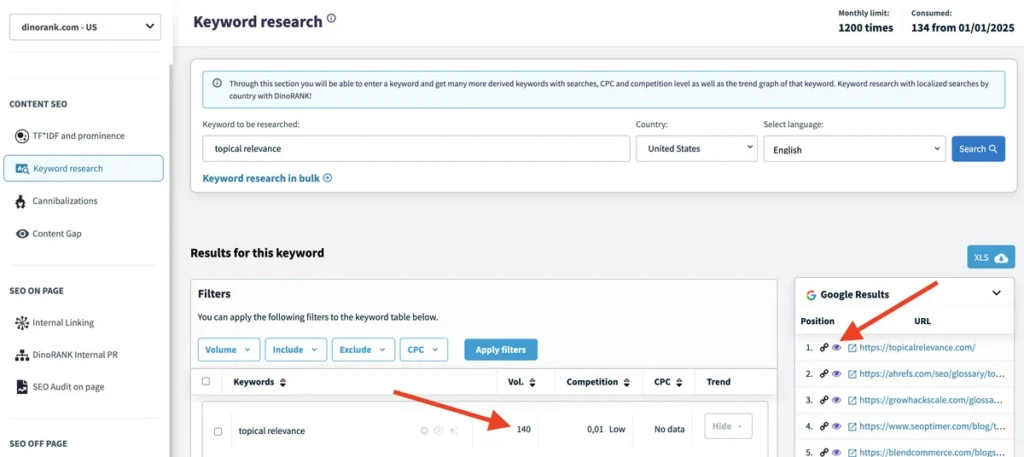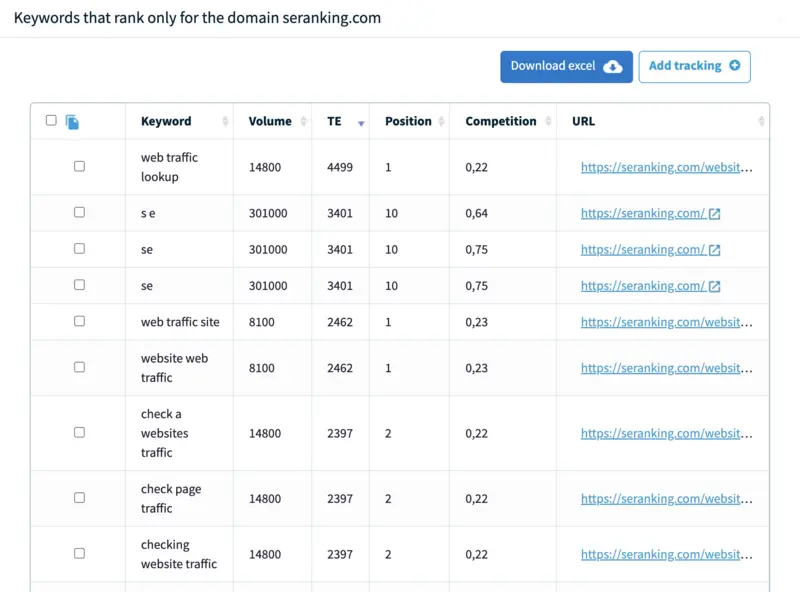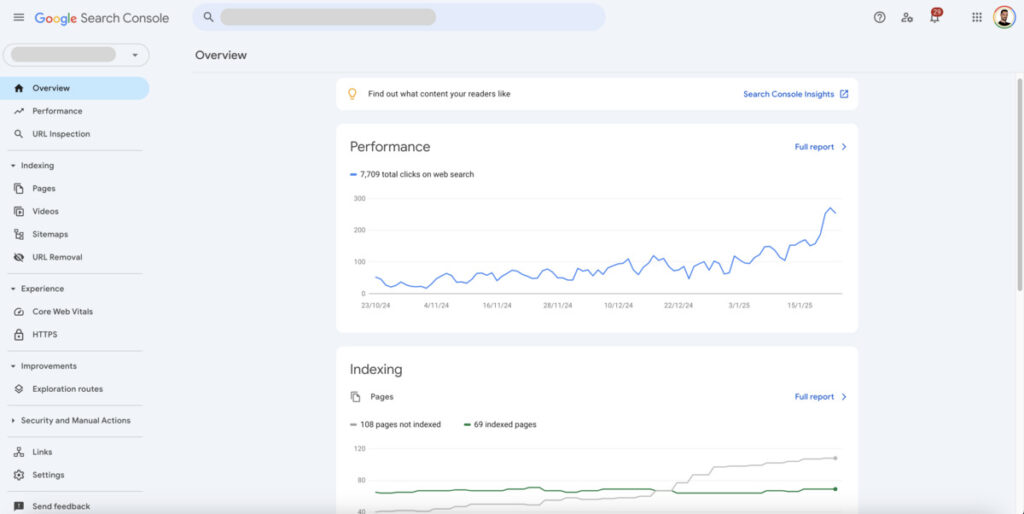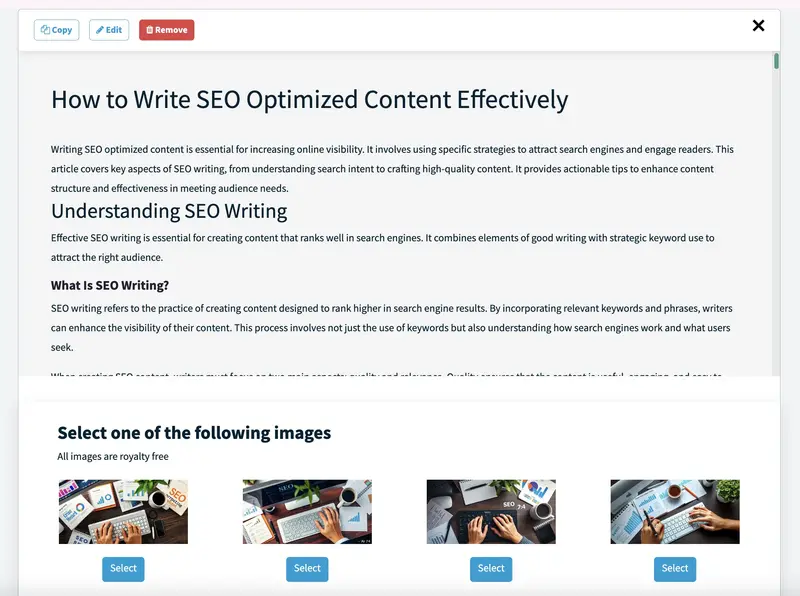Having a powerful keyword strategy is essential for effective search engine optimization. This process focuses on identifying and prioritizing keywords that address the target audience.
By aligning keyword choice with user intent, businesses can improve their visibility in search results. In this article we will discuss the key aspects you need to know in order to develop an effective keyword strategy.
In addition, I will also show you some practical examples of keyword strategies that work.
What is a Keyword Strategy?
A keyword strategy is a well-defined approach that outlines how a business intends to target specific search terms. It includes understanding the needs of the audience and identifying terms that align with those needs.
A keyword strategy serves as a roadmap for optimizing online content to attract organic traffic.
It entails selecting relevant keywords that resonate with the target audience and are likely to drive engagement.
By focusing on specific phrases, businesses can create content that directly addresses the queries and concerns of users.
- Establishes focus areas for content creation
- Guides optimization efforts across various platforms
- Enhances the alignment of content with user intent
The primary purpose of a keyword strategy is to ensure that all SEO efforts are concentrated on terms that will yield the best results.
By doing so, businesses can boost their online visibility, attract qualified leads, and ultimately enhance conversion rates.
Importance of Keyword Strategy in SEO
A well-crafted keyword strategy is essential in today’s competitive digital landscape.
Understanding the significance of targeting the right keywords can make a substantial difference in a business’s online performance.
- Drives targeted traffic: By optimizing for specific keywords, businesses can attract customers who are actively searching for their products or services.
- Improves search engine rankings: A focused keyword strategy helps in improving rankings on search engine results pages (SERPs), making it easier for potential customers to find the business.
- Enhances content relevancy: By aligning keywords with user intent, the content becomes more relevant, which can lead to better user experience and higher engagement.
- Informs marketing efforts: Keyword data provides insights into trending topics and user interests, aiding in the development of future marketing campaigns.
Furthermore, a robust keyword strategy allows businesses to differentiate themselves from competitors.
By identifying niche keywords that may be less competitive, companies can carve out their own space within the market, attracting a loyal customer base.
How to create an effective Keyword Strategy?
- Conduct thorough research
- Aligning keywords with search intent
- Evaluating keyword difficulty and competition
- Prioritizing target keywords and topics
Creating an effective keyword strategy involves multiple steps that align with business goals.
A structured approach can significantly enhance the process of identifying and prioritizing keywords that drive valuable traffic.
1. Conduct thorough research
The first step in developing a keyword strategy is to conduct thorough research. This encompasses understanding your target audience, their needs, and the specific terms they use when searching for relevant information.
Comprehensive keyword research can be facilitated through various tools that provide insights into search volumes, trends, and competition.
Additionally, it is essential to analyze existing content to pinpoint gaps and opportunities.
- Identify target audience demographics
- Conduct competitor research
- Utilize keyword research tools
2. Aligning keywords with search intent
Understanding search intent is critical for creating relevant content.
Keywords should align with the user’s purpose when searching, which can generally be categorized into three types: informational, navigational, and transactional.
- Informational: Users look for answers or information.
- Navigational: Users are trying to reach a specific site.
- Transactional: Users intend to make a purchase.
By identifying the intent behind potential keywords, businesses can create targeted content that resonates with users and improves engagement.
3. Evaluating keyword difficulty and competition
Keyword difficulty is a measure of how challenging it will be to rank for a specific keyword, often influenced by the level of competition.
Evaluating competition requires analysis of the top-ranked pages in search results. Understanding the level of difficulty helps to prioritize keywords that are more attainable based on existing authority and content quality.
- Analyze competitors’ ranking pages
- Utilize SEO tools to measure difficulty
- Assess the content quality of top results
Focusing on keywords with manageable difficulty can maximize chances of ranking while gaining visibility in niche areas.
4. Prioritizing target keywords and topics
After keywords have been identified and evaluated, the next step is prioritizing them.
Prioritization should be based on a combination of factors including search volume, relevance to business objectives, and keyword difficulty. Implementing a matrix or scoring system can aid in determining which keywords to focus on first.
- Classify keywords based on opportunity and relevance
- Optimize for high-volume, low-competition keywords
- Create content clusters around prioritized keywords
Incorporating keywords into various types of content not only assists in improving visibility but also establishes topical authority, fostering a deeper connection with the target audience.
Tools to develop your keyword strategy
Using the right tools can significantly increase the effectiveness of a keyword strategy.
They provide unique insights into keyword performance, competitive analysis and optimization opportunities.
DinoRANK: a good SEO tool to develop your Keyword Strategy
Today, I’ll talk about how DinoRANK can help you with your keyword research strategy.
1. Register and log in from your account
To start performing a keyword strategy, you need to have a DinoRANK account.
This tool will also help you to create content with the help of AI and also analyze and improve the content you have already published, thanks to other modules that you have available within its SEO suite.
2. Check if users search for your keywords (and other related ones)
From the Keyword Research module you can check if there is user demand for the most important keywords for your business.
In addition, you can find out which other terms (with the same search intent) are ranking for each of your competitors.

3. Find the keywords that are bringing organic traffic to your competitors (and not to you)
Within DinoRANK, if you go into the “Content Gap” module, you can compare your web domain with up to 5 of your main competitors.
The tool tells you which keywords they are ranking for and you are not. This is a great opportunity to discover interesting topics for your strategy.

If you work those keywords more effectively than them, it is possible that Google will rank you above them.

Using Google Search Console for insights
Google Search Console is an invaluable tool for tracking website performance in search results.

It provides insights into how the website ranks for various keywords, highlighting:
- Click-through rates (CTR) for keywords.
- Impressions and average position of the website for targeted keywords.
- Queries that are generating traffic to the site.
This information can guide adjustments in content strategy and keyword focus, ensuring better alignment with actual user behavior.
3 examples of successful Keyword Strategies
- Case studies of top-performing keyword strategies
- Analyzing competitors’ keyword strategies
- Lessons learned from successful implementations
Identifying effective keyword strategies can provide invaluable insights for businesses looking to enhance their SEO efforts.
Various case studies reveal how strategic keyword utilization has led to noteworthy improvements in search rankings and overall online visibility.
Case studies of top-performing keyword strategies
Several companies have successfully harnessed the power of keyword strategies to achieve remarkable results.
One noteworthy example is a well-known e-commerce platform that aimed to increase its visibility in a competitive market.
The brand conducted extensive keyword research to identify long-tail keywords related to its niche, such as “sustainable home goods” and “eco-friendly kitchenware.”
By optimizing product descriptions and creating unique blog content targeting these phrases, the platform saw a 40% increase in organic traffic over six months.
Another example comes from a travel website that focused on specific destinations.
They identified keywords like “best family vacation spots in Florida” and optimized their articles accordingly.
By aligning content with search intent and incorporating local SEO tactics, they improved their search rankings and increased conversions by 25% within three months.
Analyzing competitors’ keyword strategies
Understanding the keyword strategies employed by competitors can reveal valuable insights and opportunities for differentiation.
One technology company analyzed its closest rivals to uncover keyword gaps.
They discovered that their competitors focused heavily on broad keywords like “software solutions” while neglecting niche areas such as “cloud accounting for small businesses.” This finding enabled the company to pivot its strategy, allowing it to dominate search results in a less competitive space.
In the restaurant industry, a local eatery studied nearby competitors and noticed a trend in keywords associated with health-conscious dining.
By optimizing their website for terms like “plant-based meal options” and promoting local ingredients, they attracted new customers and established a reputation as a go-to spot for healthy dining in their area.
Lessons learned from successful implementations
Several key takeaways emerge from the examination of successful keyword strategies. First, aligning keywords with user intent is critical.
Businesses that focus on understanding why users search for specific terms can create content that resonates with their audience, leading to higher engagement rates.
- Prioritizing long-tail keywords can yield better results, especially in competitive industries.
- Regularly reviewing and adapting keyword strategies based on performance data is essential for ongoing success.
- Utilizing a mix of content types, including blogs, videos, and infographics, helps in capturing diverse audience interests.
Finally, leveraging analytical tools to track keyword rankings and website performance offers insights that can guide future keyword strategy adjustments. By continuously learning from both successes and failures, businesses can fine-tune their approaches and achieve sustained growth in search rankings.
Advanced keyword search strategies
- Keyword clustering and topical authority
- Optimizing for long-tail keywords
- Leveraging serp features for visibility
Advanced keyword search strategies are vital for enhancing online visibility and driving targeted traffic.
These methodologies go beyond basic keyword selection, focusing on more nuanced techniques to optimize search performance.
Keyword clustering and topical authority
Keyword clustering involves grouping related keywords into thematic clusters, enabling a more organized approach to content creation.
This strategy not only improves content relevance, but also enhances search engine understanding of the site’s niche.
Building topical authority means crafting comprehensive content that addresses various aspects of a subject. When search engines see that a site covers a topic thoroughly through clustered keywords, it may boost the site’s overall ranking potential.
- Identify primary keywords relevant to your business.
- Group secondary keywords that naturally fit within those primary themes.
- Create a pillar page for each primary keyword that links to these subtopics.
- Optimize each clustered piece with both primary and secondary keywords.
Optimizing for long-tail keywords
Long-tail keywords are phrases that are more specific and usually consist of three or more words.
They tend to have lower search volume but significantly higher conversion rates. By targeting long-tail keywords, businesses can attract highly qualified traffic looking for specific information or products.
To effectively implement a long-tail keyword strategy, businesses should:
- Conduct thorough keyword research to identify popular long-tail phrases in your niche.
- Ensure that content created around these keywords is detailed and answers potential questions.
- Use long-tail keywords in headings, meta descriptions, and throughout the content to improve visibility on search engines.
Incorporating long-tail keywords not only enhances visibility but also drives an engaged audience, leading to higher conversion rates.
Leveraging serp features for visibility
Search Engine Results Pages (SERP) features, such as snippets, local packs, and knowledge graphs, can significantly impact visibility.
Understanding and optimizing content for these features can lead to higher click-through rates and improved rankings.
To leverage SERP features effectively, one should focus on:
- Using structured data markup to enhance the chances of appearing in rich snippets.
- Creating content that specifically addresses common questions, increasing the likelihood of featured snippets.
- Optimizing for local search by including location-based keywords when relevant, thus appearing in local packs.
By tailoring content to align with SERP features, businesses can substantially increase their visibility in search results, attracting more organic traffic.
Keyword optimization in Ecommerce
- Targeting keywords for product pages
- Optimizing category pages with keywords
- Enhancing user experience through keyword usage
Effective keyword optimization is crucial for ecommerce websites.
By targeting the right keywords, businesses can enhance their visibility in search engines, attract potential customers, and ultimately increase conversions and sales.
Targeting keywords for product pages
When optimizing product pages, it is essential to choose keywords that accurately describe the product while also considering search intent.
This ensures that the right audience finds the product in search results.
Key strategies include:
- Conducting thorough keyword research to identify terms that potential customers use.
- Utilizing long-tail keywords, which can attract highly targeted traffic with a higher likelihood of conversion.
- Including keywords in critical areas of the product page, such as the product title, description, and image alt tags.
Optimizing these elements not only helps with rankings but also improves user experience by making information readily accessible.
Optimizing category pages with keywords
Category pages play a significant role in an ecommerce site’s structure. These pages should target broader keywords related to specific products.
Optimizing category pages involves:
- Creating comprehensive category descriptions that include relevant keywords. To do this, you can use DinoBRAIN to create SEO-optimized, semantically rich text.
- Utilizing internal linking strategies to connect category pages to related product pages.
- Ensuring that the category name itself is keyword-rich and description-friendly.

A well-optimized category page serves as a hub for related products, facilitating navigation and enhancing the overall shopping experience. It helps search engines understand the site’s structure and the relationship between products.
Enhancing user experience through keyword usage
Keyword optimization should not come at the expense of user experience. Balancing SEO with usability is key in ecommerce. Techniques to enhance user experience include:
- Using keywords naturally within high-quality content that addresses customer needs and questions.
- Optimizing website speed and mobile responsiveness while ensuring keyword placements do not hinder performance.
- Implementing clear calls-to-action (CTAs) that guide users toward completing purchases.
Effective keyword usage should enhance navigability and engagement on the site, leading to a better overall experience for users.
Techniques to improve keyword ranking
Improving keyword ranking requires a multi-faceted approach.
By focusing on specific strategies and techniques, businesses can significantly enhance their visibility in search engine results and attract more organic traffic.
On-page optimization for keywords
It plays a fundamental role in determining how well content ranks for particular keywords.
Various elements should be adjusted to ensure maximum effectiveness:
- Title Tags: Include primary keywords in the title tags of web pages. Ensure titles are concise, relevant, and compelling to encourage clicks.
- Meta Descriptions: Utilize unique meta descriptions incorporating keywords, which summarize page content and can improve click-through rates.
- Header Tags: Structure content with H1, H2, and H3 tags that integrate keywords, facilitating quick understanding of the content hierarchy.
- Content Quality: Produce high-quality, informative content that addresses user intent. Keywords should be naturally integrated without keyword stuffing.
- Image Optimization: Use relevant keywords in alt text and filenames for images. This boosts visibility in image searches and enhances SEO.
Improving CTR for higher rankings
Click-through rates (CTR) are critical for indicating to search engines that content is relevant.
Higher CTR helps to improve rankings over time. Below are techniques to boost CTR:
- Engaging Titles: Craft titles that inspire curiosity and draw potential visitors in, encouraging clicks over competitors.
- Compelling Meta Descriptions: Write informative yet intriguing descriptions that highlight the value of the content. Utilizing calls to action can prompt searchers to take action.
- Rich Snippets: Implement structured data to enable rich snippets, such as star ratings or product availability, which make listings more appealing in SERPs.
- Ad Extensions: Utilize sitelinks and other extensions in PPC campaigns, as this can improve visibility and lead to higher traffic from users interested in the content.
Tracking and adapting to keyword ranking changes
Continuous monitoring and adaptation are essential elements in maintaining and improving keyword rankings. Here are key practices for effective tracking:
- Utilizing Analytics Tools: Tools such as Google Analytics and Google Search Console provide valuable insights into keyword performance, traffic sources, and user behavior.
- Setting Benchmarks: Establish performance benchmarks for keyword rankings, allowing for an easier evaluation of trends and shifts over time.
- Regular Audits: Conduct periodic audits of content effectiveness to identify underperforming keywords and adjust strategies for improvement.
- Competitor Analysis: Keep an eye on competitors’ keyword strategies to adapt and innovate approaches as market dynamics change.


